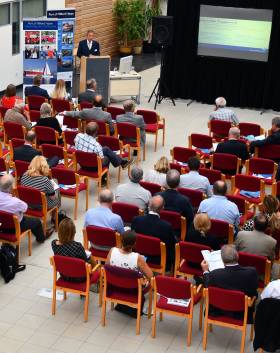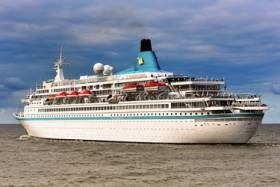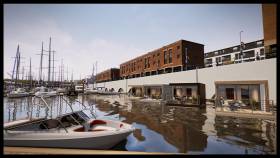Displaying items by tag: Milford Waterfront development
#Ports&Shipping - Residents and businesses in south Wales have expressed increased approval of the Port of Milford Haven’s performance over the last year, in the latest annual survey carried out on behalf of the Pembrokeshire port.
When asked how the Port was performing against their overall expectations, 85% of respondents responded positively, which is a 3% increase from last year and 17% increase over 2 years.
The impact of port operations and their influence on Pembrokeshire appears to be felt deeper into the hinterland than in previous years with nearly a third of respondents motivated to take part coming from inland areas away from the traditional port communities.
Other shifts in public perception include a further swing behind the Port’s strategy to promote renewable energy industry in Pembrokeshire, with an 8% increase in support (to 83%).
The Port magazine Onboard, which goes out to homes and businesses along the Waterway has grown in influence over the three years since its launch. It is now cited as the second most useful form of communication coming from the Port.
A recurring theme, reflecting the economic uncertainty felt in Pembrokeshire at the moment, was a call for the Port to continue to play a leading role in promoting and supporting new business opportunities on the Waterway with 90% in support. (See coverage on Milford Waterfront) Respondents also put forward a broad range of suggestions for how the Port should be investing in a way that attracts new trade and investment and supports communities and local interest groups.
“The responses underline how important it is for us to remain a strong business so that we can fulfil the role of a Trust Port, nurturing economic activity and communities around the Waterway,” said Alec Don, Chief Executive of the Port of Milford Haven. “It’s clear a busy working port is good for the county and good for the nation too,” he added. “We take that responsibility very seriously and need to work with our partners to ensure we remain a principle agent for economic growth and prosperity in Pembrokeshire.”
The full Stakeholder Survey Report can be read on the Port’s website www.mhpa.co.uk/stakeholder-survey
#CruiseLiners - A cruiseship that is due to Dublin Port tomorrow is at the time of writing entering the deepwater south Wales port of Milford Haven this afternoon.
The German cruiseship Albatros will become the first caller in Milford Haven this year. The port is expecting a busy cruise season with a further two callers scheduled this month bringing over 1,000 passengers to the area, and an additional six calls planned between July and September.
Albatros is notable for the bright turquoise funnel rising above the white ship. The cruiseship embarked passengers in Bremerhaven, Germany for a cruise around Britain and arrives at Milford Haven this morning and is to anchore at Milford Shelf (just outside Milford Marina) until 8pm.
The next port of call as alluded is Dublin Port. Afloat adds that the elegant first-generation cruiseship operated by Pheonix Reisen has been allocated a berth at Ocean Pier. The 28,000 gross tonnage cruiseship has called to the capital before and other Irish Sea ports having entered service in 1973.
Returning to the team at Milford Waterfront, including port staff, local businesses and entertainers will be on the quayside to extend a warm Welsh welcome as visitors come ashore.
On Sunday, ‘Silver Cloud’ will call at Pembroke Port (the ferryport is also located in the Haven). Shortly after that, on 20th May, ‘MV Seabourn Quest’ will call into Milford Haven. This is a luxury cruiseship offering award-winning dining experiences and high end décor. The call willl be part of a 15-day tour of the British Isles and Iceland.
For passengers choosing to stay in Milford Haven, there is an expanding range of things to do. From a visit to Milford Museum, a bite to eat at one of many cafes and restaurents in Milford Waterfront (see related development story) or a spot of retail therapy along the promenade and in the town centre.
#Ports&Shipping - The south Wales Port of Milford Haven (related story) has submitted a revised master plan to Pembrokeshire County Council for its multi-million pound Milford Waterfront development.
The Port received a resolution to grant planning consent in 2015 and since then work has been ongoing to finalise the details for the five phases of development. A significant milestone has been achieved with regards to the location of the new access following approval from Welsh Government, enabling the listed building currently occupied by a vets practice to be retained.
The previous plans were centred largely around a retail development but as a result of market changes the development will now be leisure-led and the food retail store has been replaced with a large indoor leisure facility, offering an interactive digitally-led experience for all ages which will be open all year round.
A second upmarket hotel has been added in line with the desire to create a leisure and tourist destination and a high quality restaurant on stilts is envisaged for the north end of the marina, which can be accessed from the marina or from the quayside. The dry dock will no longer be in-filled, but instead used for private berthing alongside new residential accommodation overlooking the marina and Haven.
Opposite the entrance to Milford Waterfront the Quay Stores building will be redeveloped, bringing a listed building back into use. The link between the town’s train station and Havens Head Retail Park will also be landscaped to create a welcoming experience for visiting rail passengers and safe access to the marina.
Neil Jenkins, Development Director at the Port of Milford Haven, said “We have worked hard on fine-tuning the plans over the past couple of years to ensure they are in line with market trends and are confident that we’re now in a position to deliver a fantastic development in a unique waterfront setting which will provide huge economic benefits to the Pembrokeshire and Welsh economies.”
He added “Work has already started on site for a new Costa Coffee Drive-Thru at Milford Waterfront, a new visitor centre has been opened within the museum and later this year we’ll be launching a new holiday let overlooking the Haven as well as four Floatel Cabins in the marina with terraces overlooking the water. It’s an exciting time for the area and we look forward to receiving feedback from the local authority.”
The Milford Waterfront development is set to create over 700 jobs during the construction and operational phases and result in an additional £9 million in visitor spend.
The planning application can be viewed on Pembrokeshire County Council’s website at www.pembrokeshire.gov.uk
For more details about Milford Waterfront visit www.milfordwaterfront.co.uk
































































